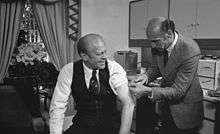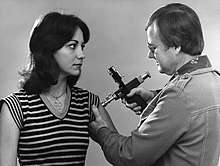1976 swine flu outbreak

In 1976, an outbreak of the swine flu, Influenza A virus subtype H1N1 at Fort Dix, New Jersey caused one death, hospitalized 13, and led to a mass immunization program. After the program began, the vaccine was associated with an increase in reports of Guillain-Barré Syndrome, which can cause paralysis, respiratory arrest, and death. The immunization program was ended after approximately 25% of the population of the United States had been administered the vaccine.
Richard Krause, Director of the National Institute of Allergy and Infectious Diseases from 1975 to 1984, writes that the government response to the swine flu outbreak was considered to be too fast and the response to the AIDS epidemic too slow.[1]
Chronology
In January 1976 [2] Several soldiers at Fort Dix complain of a respiratory illness diagnosed as influenza. The next month, Private David Lewis, who had the symptoms, participates in a five-mile forced march, collapses and dies. The New Jersey Department of Health tests samples from the Fort Dix soldiers. While the majority of samples were of the more common A Victoria flu strain, two were not. The atypical samples are sent to the Centers for Disease Control in Atlanta, Georgia, which finds evidence of Swine Influenza A, related to the 1918 flu pandemic which killed 50-100 million people worldwide.
The Center for Disease Control, as it was then called, verifies the findings and informs both the World Health Organization and the state of New Jersey. On February 13, CDC Director David Sencer completed a memo calling for mass immunization for the swine flu. The CDC Assistant Director for Programs of the Center for Disease Control, Bruce Dull, holds a press conference on February 19[3] to discuss the flu outbreak at Fort Dix and, in response to questions from reporters, mentions the relationship of the flu strain to the 1918 outbreak.[4]
President Gerald Ford is officially informed of the outbreak memo on March 15 [5] and the suggested immunization program. He meets with a "blue ribbon" panel which includes Jonas Salk and Albert Sabin.[6] Ford then makes a televised announcement in support of the mass immunization program. A hearing is held before the United States Senate Appropriations Subcommittee on Labor, Health and Human Services, Education, and Related Agencies, and C. Joseph Stetler, drug company spokesman, requests government indemnity for the vaccine manufacturers.[7]
The House Appropriations Committee reports out a special appropriations bill including $135 million for the swine flu immunization program. It is approved on April 5. Two days later, the World Health Organization holds a conference to discuss the implications of a swine flu outbreak for poorer nations.
On April 8, an official from the Federal Insurance Company informs Merck & Co., a manufacturer of the swine flu vaccine, that it will exclude indemnity on Merck's product liability for the swine flu vaccine starting July 1, 1976. T. Lawrence Jones, president of the American Insurance Association, informs the Office of Management and Budget that the insurance industry will not cover liability for the vaccine unless the government extends liability protection. The chairman of Merck writes a memo a day later, April 13, to various government agencies including the White House emphasizing the "duty to warn." In May, other vaccine manufacturers including Marion Merrell Dow, Parke-Davis, Wyeth are notified of indemnity problems by their respective insurers. Assistant Secretary Theodore Cooper (HEW) informs the White House on June 2 that indemnity legislation will be needed to secure Merrell's cooperation. During June other vaccine manufacturers request the same legislation. A little more than two weeks later, the Ford Administration submits a proposal to Congress offering indemnity to vaccine manufacturers.
Bruce Dull states at a flu conference on July 1 that there are no parallels between the 1918 flu pandemic and the current situation. Later that month, J. Anthony Morris, a researcher in the Food and Drug Administration's Bureau of Biologics (BoB) is dismissed for insubordination and goes public with findings that cast doubt on the safety of the vaccine. Three days later, several manufacturers announce they have ceased production of the vaccine. In the latter part of the month, investigations into alleged swine flu outbreaks in other parts of the world find no cases of the strain. On July 23, the President sends a letter urging Congress to take action on indemnification.
In early August an outbreak of illness in Philadelphia is thought to be related to swine flu.[8] It is found to be an atypical pneumonia thereafter called Legionnaires' disease. On August 6, President Ford holds a press conference urging Congress to take action on the indemnification legislation. Four days later, both Houses of Congress pass the legislation.
Merrill becomes the first company to submit samples to the FDA's Bureau of Biologics for safety testing, which approves it on September 2. Merck makes the first shipment of vaccines to state health departments by September 22. The first swine flu inoculations are given at the Indiana State Fair.

In October, three people die of heart attacks after receiving the vaccine at the same Pittsburgh clinic, sparking an investigation and recall of that batch of vaccine. Investigation shows that the deaths were not related to the immunization.The President and his family receive their immunizations before the television cameras.[9] On November 2, Gerald Ford loses presidential election to Jimmy Carter
Also in early November, Albert Sabin publishes a New York Times editorial, "Washington and the Flu." [10] He agrees with the decision to create the vaccine and be prepared for an outbreak, but criticizes the "scare tactics" used by Washington to achieve the goal. He suggests stockpiling the vaccine and having a wait-and-see strategy. Cases of Guillain-Barré syndrome affecting vaccinated patients are reported in several states, including Minnesota, Maryland, and Alabama.[11]
Three more cases of Guillain-Barré reported in early December and the investigation into cases of it spreads to eleven states. On December 16, a one-month suspension of the vaccination program is announced by CDC head Sencer. William Foege of the CDC estimates that the incidence of Guillain-Barré is four times higher in vaccinated people than in those not receiving the swine flu vaccine. The President tells reporters that he agrees with the suspension, but defends the decision to create the immunization program. Joseph A. Califano, Jr. is sworn in as Secretary of Health, Education, and Welfare on January 20, 1977. On February 4, Sencer is informed that he will be replaced as the head of the CDC. The immunization program is not reinstated.
Dr. David Sencer returns to public service, serving as health commissioner for New York City in 1982, and is criticized by the gay community for dragging his feet in response to the AIDS epidemic.[12]
Aftermath
Laurence Gostin in his article At Law: Swine Flu Vaccine: What Is Fair?[13] writes that "…the swine flu affair fails to tell us whether, in the face of scientific uncertainty, it is better to err on the side of caution or aggressive intervention." There is not even complete agreement about the causal relationship between the swine flu vaccine and Guillain-Barré syndrome, as noted in Gina Kolata's book Flu: The story of the great influenza pandemic of 1918 and the search for the virus that caused it..[14] She writes that the CDC did not have a "specific set of tests and symptoms to define Guillain-Barré" and that doctors who reported cases already knew that a link was suspected, so a bias in reporting was introduced. She quotes Keiji Fukuda, "...if a new virus gets identified or reappears, you don't want to jump the gun and assume a pandemic is happening."[14]
See also
| Wikimedia Commons has media related to 1976 swine flu outbreak. |
References
- ↑ Krause, Richard (January 2006). "The Swine Flu Episode and the Fog of Epidemics". Emerging Infectious Diseases. Washington, DC: National Institutes of Health. 12 (1): 40–43. doi:10.3201/eid1201.051132. PMC 3291407. PMID 16494715.
- ↑ Neustadt, R.E. "Swine Flu Chronology January 1976—March 1977". The National Center for Biotechnology. The National Center for Biotechnology. Retrieved November 10, 2017.
- ↑ Schmeck, Harold M. Jr. (February 20, 1976). "On Possible Return Of Epidemic's Virus". New York Times. p. 69. Retrieved December 4, 2017.
- ↑ Schmeck, Harold M. Jr. (February 20, 1976). "U.S. Calls Flu Alert On Possible Return Of Epidemic's Virus". New York Times: 1.
- ↑ Neustadt, R.E. "Swine Flu Chronology January 1976—March 1977". The National Center for Biotechnology. The National Center for Biotechnology. Retrieved November 10, 2017.
- ↑ Boffey, Philip M (September 5, 1976). "Soft evidence and hard sell". New York Times. p. 137. Retrieved December 4, 2017.
- ↑ Spivak, Jonathan (June 18, 1976). "Shot in the Army: Program to Inoculate All Americans for Flu Appears to Be Ailing". Wall Street Journal. p. 1. Retrieved November 12, 2017.
- ↑ Altman, Lawrence K. (August 3, 1976). "Deaths of 6 to 14 Who Attended Convention Studied". New York Times. p. 12. Retrieved December 5, 2017.
- ↑ "Fords get their flu shots; some clinics, closed after deaths, are reopened". The Sun (Baltimore). Associated Press. October 15, 1976. p. A1. Retrieved December 5, 2017.
- ↑ Sabin, Albert (November 5, 1976). "Washington and the Flu". New York Times: 21.
- ↑ "Illness found in 10 states: Swine flu shot link to paralysis studied". Chicago Tribune. December 15, 1976. p. 2. Retrieved December 5, 2017.
- ↑ Weber, Bruce (May 10, 2011). "DAVID J. SENCER - NOV. 10, 1924 - MAY 2, 2011 - HEADED FEDERAL AGENCY FIGHTING SOME OF THE WORLD'S TOUGHEST DISEASES". Pittsburgh Post Gazette.
- ↑ Gostin, Lawrence (2009). "At Law: Swine Flu Vaccine: What Is Fair?". The Hastings Center Report. 39 (5): 9–10. doi:10.1353/hcr.0.0184. JSTOR 40407644.
- 1 2 Kolata, Gina (1999). Flu: The story of the great influenza pandemic of 1918 and the search for the virus that caused it. New york: Farrar, Straus and Giroux. pp. 182–185. ISBN 0374157065.